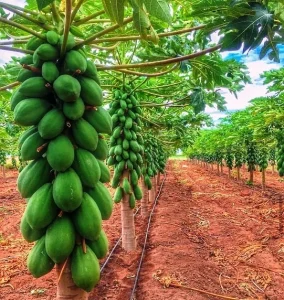Attention all eco-warriors and savvy farmers! Did you know that planting trees can combat climate change and earn you some cold, hard cash?
In Kenya, growing trees for carbon credits is catching on as a sustainable way to mitigate carbon emissions while providing income for rural communities. In fact, with one of the highest participation rates in carbon credit programs globally, Kenya is becoming a leader in this field.
But with so many tree species, which ones are the best for carbon sequestration? Fear not, we’ve compiled a list of the top 10 trees to grow in Kenya for carbon credits. So, roll up your sleeves, grab your gardening gloves, and let’s get planting!
10 Best Trees for Carbon Credit Programs
1. Moringa
Moringa is a fast-growing tree that is native to India but is now widely cultivated in Kenya and other parts of the world. It has a high potential for carbon sequestration and can also provide a range of social and environmental co-benefits, including soil conservation, water purification, and food security. Moringa is also a valuable source of nutrition and can be used for various products, including food, animal feed, and cosmetics.
2.Casuarina Equisetifolia:
Also known as the Australian pine, this tree is a fast-growing species that is commonly used for reforestation projects and timber production. It has a high potential for carbon sequestration and can also provide valuable ecosystem services such as erosion control and shade.
3 Grevillea robusta
Grevillea is a fast-growing tree that is native to Australia but has been widely planted in Kenya and other parts of the world for timber production and reforestation projects. It has a high capacity for carbon sequestration and can also provide a range of ecosystem services such as soil conservation, erosion control, and habitat for wildlife.
4. Cupressus lusitanica
Also known as the Mexican cypress, this tree is commonly planted in Kenya for timber production and reforestation projects. It has a high potential for carbon sequestration and can also provide important ecosystem services such as soil conservation and habitat for wildlife.
5. Melia volkensii
Melia is a fast-growing tree that is native to East Africa and is commonly used for timber production and agroforestry projects. It has a high capacity for carbon sequestration and can also provide important ecosystem services such as soil conservation, erosion control, and habitat for wildlife.
6.Eucalyptus camaldulensis
This species of eucalyptus is widely planted in Kenya for timber production and reforestation projects. It is a fast-growing tree with a high capacity for carbon sequestration and can also provide valuable ecosystem services such as soil conservation and habitat for wildlife.
7.Acacia mangium
Acacia mangium is a fast-growing tree that is native to Southeast Asia but has been widely planted in Kenya and other parts of the world for timber production and agroforestry projects. It has a high potential for carbon sequestration and can also provide important ecosystem services such as soil conservation and erosion control.
8.Terminalia brownii
Also known as the East African Terminalia, this tree is native to East Africa and is commonly used for timber production and agroforestry projects. It has a high capacity for carbon sequestration and can also provide important ecosystem services such as soil conservation and habitat for wildlife.
9.Ficus natalensis
This species of fig tree is native to Africa and is commonly used for agroforestry projects and soil conservation. It has a high potential for carbon sequestration and can also provide valuable ecosystem services such as erosion control and habitat for wildlife.
10.Markhamia lutea
Markhamia is a fast-growing tree that is native to East Africa and is commonly used for timber production and agroforestry projects. It has a high capacity for carbon sequestration and can also provide important ecosystem services such as soil conservation and habitat for wildlife.
In conclusion, growing trees for carbon credits effectively fight climate change while providing economic benefits to rural communities. Farmers in Kenya have already embraced this sustainable practice, and with the right knowledge and support, they can continue to impact the environment and their livelihoods positively.
By planting the 10 trees we’ve highlighted in this article, farmers can sequester large amounts of carbon, contribute to biodiversity, improve soil quality, and create a sustainable source of income. The benefits of growing trees for carbon credits extend far beyond just mitigating climate change. They provide a path toward a greener and more equitable future for everyone.



By promoting the planting of foreign tree species in Kenya, are you not concerned with the long term impacts on Kenya’s ecosystem? Other than Melia volkensii, you list 9 foreign species. In Hawaii where I live, Ficus, Eucalyptus and Casuarina are considered invasive. Aren’t there any native species that you could be promoting locally for carbon sequestration projects?